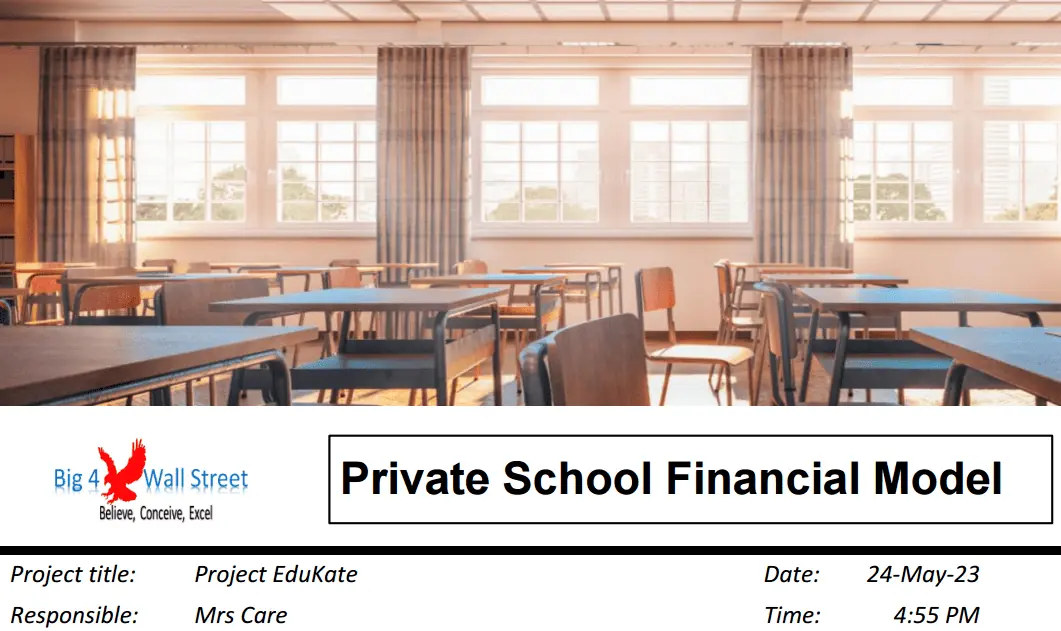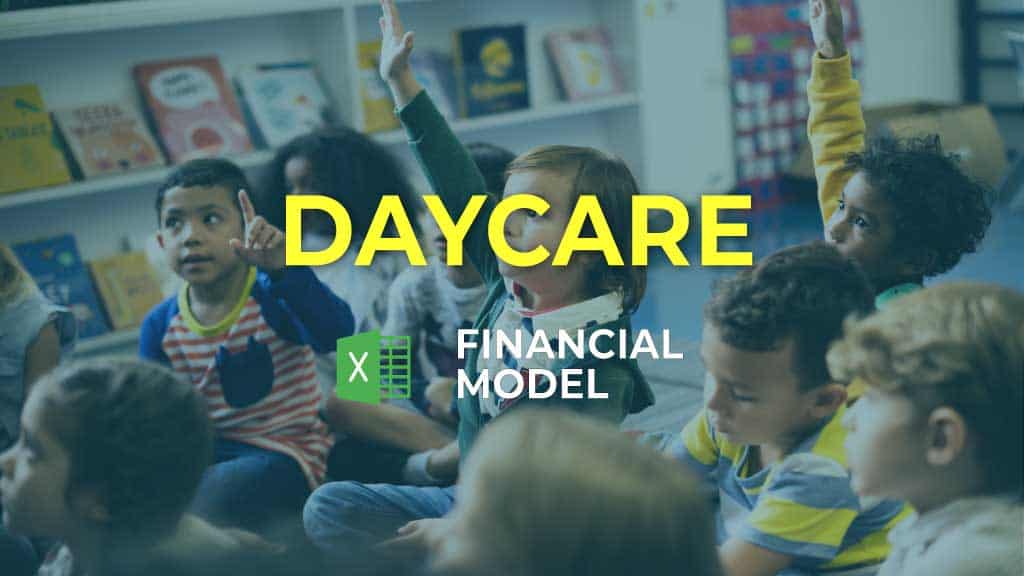Childcare Center Financial Plan
The Childcare Center business model template aims to forecast the financial feasibility and profitability of starting a childcare business. This financial model contains valuable tools that allow users to analyze and develop financial projections that cover a horizon of 5 to 10 years – depending on the model version. These financial data can clarify the possible childcare profit margins, the funding required, and the expected returns. This solid and unique financial model template can be the missing piece to bringing the childcare business to financial success.

The Childcare Center Financial Model aims to forecast the financial feasibility and profitability of starting a childcare business. This childcare business plan template covers a forecast horizon of 5 to 10 years – depending on the model version – and is based on bottom-up revenue and expense assumptions, where the model forecasts the yearly revenues of three different childcare center programs – Nursery, Preschool, and Kindergarten.
Other assumptions include three childcare center schedules and their respective childcare fees per program, direct costs, teacher-to-child ratio to identify the Childcare Center’s nursery, preschool, and kindergarten number of teachers, other childcare worker overhead costs, operating costs, and uses and sources of funds. These assumptions are then translated into a comprehensive financial plan that allows the business owner and management to obtain visibility of how the business should perform from a financial perspective over the following years.
The childcare center business plan template includes a variety of charts and tables to understand the financial plan for the childcare center in detail. Calculations of the relevant financial ratios and metrics (such as childcare center profit margin, IRR, and NPV) are also included.
What makes this Childcare Center Business Financial Model unique?
This financial model template has the following unique aspects:
1. Childcare Program and Schedules: Children are allocated to three childcare programs with three schedules. The financial model allows the user to indicate respective childcare fees per program and schedule.
2. Payment Schedule: Payments can be made either monthly, semi-annually, or annually, which allows payment discounts.
3. Start of Childcare Program: Users may flexibly set which month of the first year of operation the childcare center program starts.
4. Build or Rent Option: Choosing the build option enables the childcare center business to recognize an initial CAPEX for the property, while the rent option leads to childcare rent operating expense to be incurred monthly.
Deciding whether to invest or not in starting a childcare business, one requires a well-prepared and executed finance plan. Developing financial projections can clarify the possible childcare profit margins, the funding required, and the expected returns. This solid and unique financial model template can be the missing piece to bringing the childcare business to financial success.
Childcare Center Business Plan Template Structure
The financial model is structured with instructions and formulas that are simple and easy to follow, which allows users to run simulations by varying the input assumptions. The elements of this financial model template are enumerated below:
Terms contain the cell color codes and the terms and abbreviations used.
Executive Summary and Detailed Summary include charts to understand your Childcare Center Business’ financial reports and business plan better and to answer important questions such as:
- Are Childcare Centers profitable?
- How much profit margin does a childcare center make?
- How much are the childcare fees and costs per month?
- Which childcare program generates the most revenue and gross profit?
These spreadsheets include a 5 or 10-year summary of the following:
- Projected Childcare Center Financial Statements overview – Income Statement, Balance Sheet, and Cash Flows Statement.
- Levered and Unlevered Free Cash Flows calculating key financial feasibility metrics such as the Internal Rate of Return (IRR), Payback Period, Net Present Value (NPV)
- Uses and Sources of Funds
- Forecasted Business Valuation and expected investment implied multiples
- Revenue and Number of Children Summary
- Childcare Business Profit and Cost Analysis
In the premium version, the Executive Summary contains results of the Break-Even Analysis of chosen year and the Shareholders’ Summary.
Assumptions that are necessary and applicable in childcare center startups are presented in this worksheet.
- General Settings
- Currency
- Annual Working Days and Average days per month
- Income Tax Rate
- Net Working Capital
- Operational Assumptions
- Starting month of childcare program
- Number of Children
- Percentage allocation of the number of children to Program and Schedule
- Childcare Fees
- Deferred Revenue Assumptions for Childcare Fees
- Other Income
- Direct Costs – Direct Salaries and Wages, Supplies Cost, and Others
- Childcare Teacher-to-child Ratio
- Salaries and Wages of Full-Time Equivalent Staffs
- Operating Expenses – Utilities, Other Expenses, and Indirect Salaries and Wages
- Price and Cost Inflation rates
- Building Option – Buy or Rent
- Uses and Sources of Funds
- Capital Expenditures, CAPEX Schedule, and Maintenance per year
- Depreciation Periods
- Financial Assumptions such as Interest Rates, Bank Covenants, and Dividend Policy
- Exit and Valuation assumptions such as the Investment Period, Discount Rate, and Exit Valuation Multiples
This sheet allows users to encode up to 5-year assumptions, giving the user a brief idea of the output of encoded assumptions by illustrating the computed yearly summary.
CAPEX (Capital Expenditures) schedule illustrates the allocation of the amount of CAPEX spent by spreading their percentages through the current year up to the first. Maintenance CAPEX is calculated using the annual maintenance percentage and will only begin the year after the Initial CAPEX drawdown is at 100%. This sheet also shows the depreciation schedule and the yearly summary of Gross Fixed Assets, Depreciation, and Net Fixed Assets.
Monthly worksheet contains a detailed calculation of the 5 to 10-year summary, depending on the model version, and a monthly assessment of childcare center financial planning and feasibility. This monthly report presents the operational forecasts of:
- Number of Children – Beginning, Changes, and Ending
- Childcare Fees Summary
- Deferred Revenue and Revenue Recognition of Childcare Fees
- Other Income
- Revenue
- Cost Inflation Rates
- Childcare Teachers Schedule
- Salaries and Wages
- Direct Costs
- Childcare Operating Expenses
- Monthly Childcare Center Financial Statements – Income Statement, Balance Sheet, Cash Flow Statement
- Monthly Unlevered and Levered Free Cash Flow Statement
- Funding Required
Special features of this worksheet include the following:
- Number of children, other income, certain childcare direct costs, and operating expenses will start to be earned and incurred depending on the selected assumption of when the childcare program will start.
- Detailed computation of the Deferred Revenue and Revenue Recognition of Childcare Fees
Yearly worksheet contains a comprehensive and detailed summary of the 5 or 10-year, depending on the model version, monthly forecast of the Childcare Center:
- Financial Statements – Income Statement, Balance Sheet, Cash Flow Statement
- Financial Ratios
- Standardized Income Statement
- Number of Children Summary
- Gross Profit per Program
- Childcare Fee Summary
- Deferred Revenue and Payment Terms Summary
- Childcare Teachers Summary
- Projected Enterprise Value
- Unlevered and Levered Free Cash Flow Forecast
- Financial Metrics, and
- Equity Funding and Divided Policy Schedule
Debt Schedule is specially prepared to be presented to banks and investors for funding purposes. It contains financial ratios the banks and investors review when evaluating a project’s financial feasibility. The debt schedule comes with two debt facility options and adjustments for drawdowns and repayments.
Break-Even Analysis (only in Premium Version) shows the calculations of break-even at a selected year at an EBITDA level to answer the following:
- What is the total Number of Children needed to reach Break-Even?
- What is the Average Childcare Fee to reach Break-Even?
This sheet also shows a break-even sensitivity analysis.
Shareholders Cash Flow (only in Premium Version) is prepared to show the calculations of the Equity Multiple and Investors’ IRR, which helps determine if their funding and equity stake percentages would result to profit on their end. User has the option to select which Cash Flow – Levered Cash Flow or Cash In/Out, will be used to compute investment and proceed.
Start your own Childcare Center Business now!
This Childcare Center business financial model template contains valuable tools that allow users to analyze the financial plan of starting a childcare business in detail by testing various scenarios and assessing how it affects the project’s viability.
The financial model template comes pre-filled with a 5 or 10-year monthly forecast, which users may modify easily by updating the marked assumptions in blue or light blue.
The model, current version 1.2, is available in two fully editable Excel versions:
- Premium Version (Excel file, fully editable) – 10-Year financial projection containing all features
- Basic Version (Excel file, fully editable) – 5-Year financial projection containing all features except for the Break-Even Analysis and Shareholder’s Cash Flow
Both versions are also available in PDF Demo Preview (which outlines the details of the model structure).
File types:
.xlsx (MS Excel)
.pdf (Adobe Acrobat Reader)
Similar Products
Other customers were also interested in...
Financial Plan for the Startup of a University and...
The University and School Financial Model aim to plan the operations, financial feasibility, and pro... Read more
Culinary Arts Academy – 10 Year Financial Mo...
Financial Model providing a dynamic up to 10-year financial forecast for a startup or existing Culin... Read more
Private School Financial Model – 10+ Year DC...
A financial model for a private school business serves as a comprehensive tool to forecast and analy... Read more
Online Tutoring Services Financial Model (10+ Yrs ...
The Online Tutoring Services Financial Model is a comprehensive tool designed to analyze the financi... Read more
Day Care Financial Model Excel Template
Discover Daycare Financial Model. Spend less time on Cash Flow forecasting and more time on your pro... Read more
Scuba Diving Center – 5 Year Financial Model
Scuba diving affords an unparalleled experience with the underwater world. However, safe diving requ... Read more
Coding Bootcamp Financial Model – 10+ Year D...
The Coding Bootcamp Financial Model DCF and Valuation is a comprehensive tool designed to analyze th... Read more
Driving School – 5 Year Financial Model
Financial Model providing an advanced 5-year financial plan for a startup or operating Driving Schoo... Read more
Foreign Languages School – 5 Year Financial Mode...
Financial Model providing an advanced 5-year financial plan for a startup or operating Foreign Langu... Read more
Nursery School Financial Model – 5 Year Busi...
General Overview Highly-sophisticated and user-friendly Financial Model providing advanced financ... Read more
You must log in to submit a review.



























